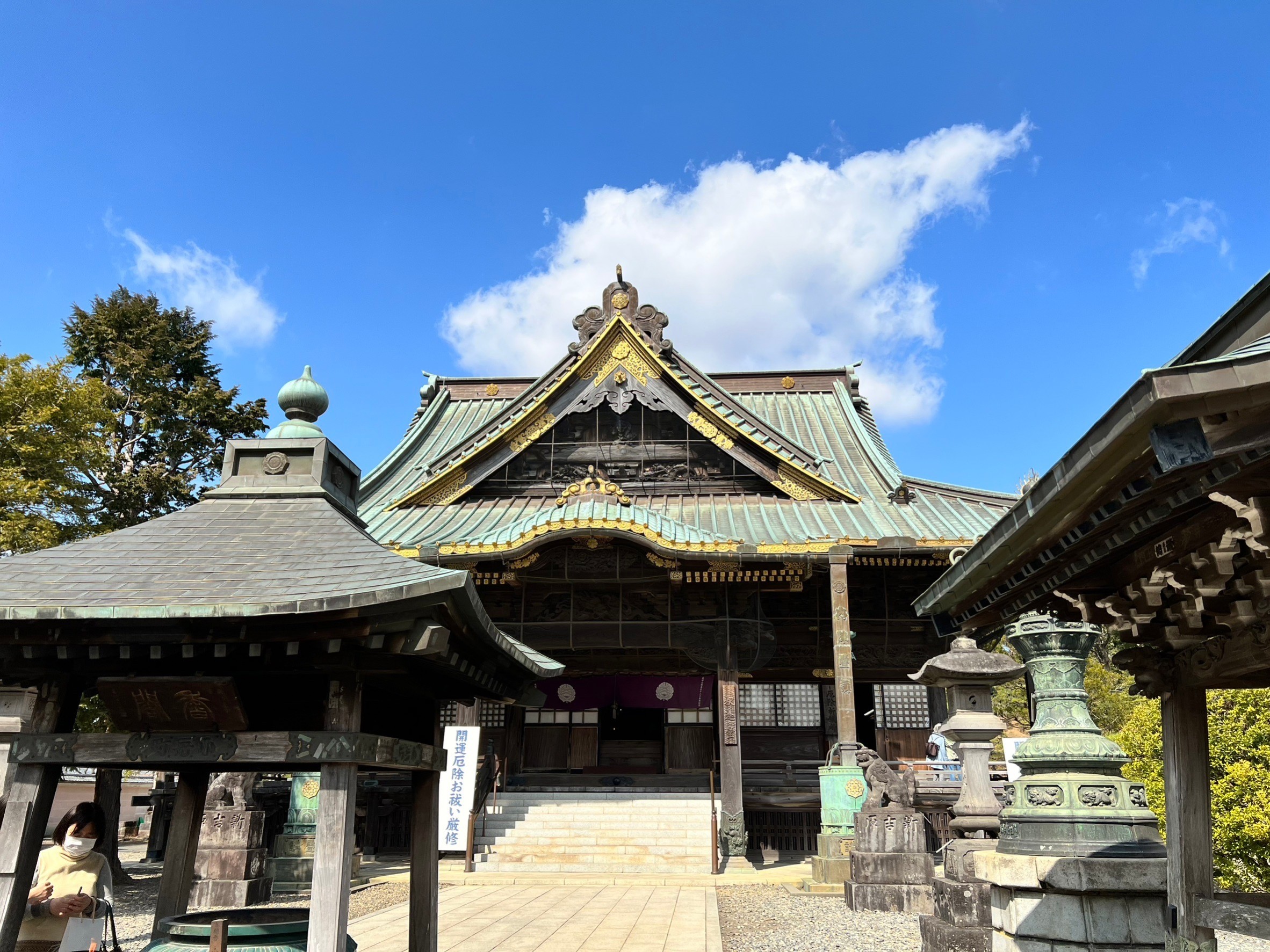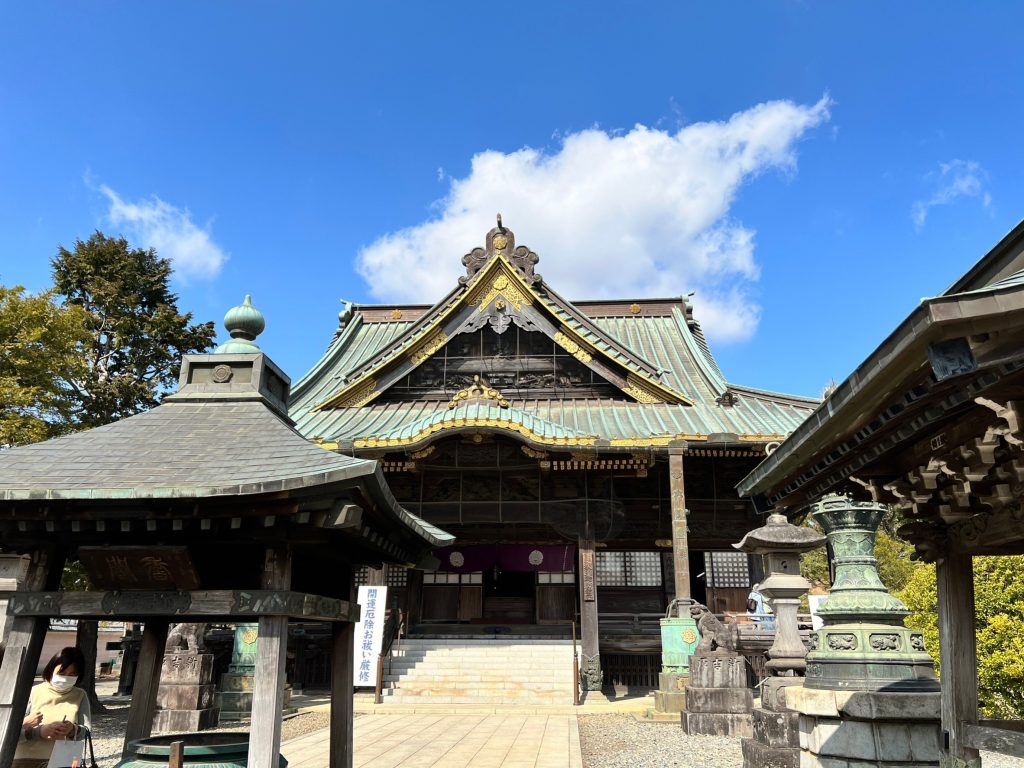
- About the origin of the history and foundation of Naritasan Shakado
- About the sect of Buddhism to which Naritasan Shakado belongs (Chisan sect of Shingon sect) and its teachings
- Appearance, internal structure, characteristic design and decoration of Naritasan Shakado building
- About the statue of Shakyamuni Buddha enshrined in Shakado
- Manners and procedures for visiting Naritasan Shakado
- Highlights of the precincts of Naritasan Shakado
- Events, annual events, and special events held at Naritasan Shakado
About the origin of the history and foundation of Naritasan Shakado
Naritasan Shakado (Naritasan Shinshoji Temple) has a long history, and legends are passed down about the origin of its foundation. Below is an overview of its history and origins.
History: Naritasan Shakado is a temple located in Narita, Chiba Prefecture, Japan, belonging to the Shingon sect of Buddhism. The foundation of the temple dates back to the middle of the Heian period, over 1,000 years ago. It has a long history, and has undergone many repairs and reconstructions to the present day.
Origin of the founding: There is a legend about the founding of Naritasan Shakado. According to legend, a monk named Kukai (Kobo Daishi, Koukai) in the Heian period was traveling around the eastern part of Japan when an evil entity called Onyo was committing evil deeds in Narita. I witnessed
Kukai carved a statue of Dainichi Nyorai (Buddha statue of Dainichi Nyorai) in the land of Narita in order to get rid of the demon woman and performed a blessing to exorcise evil spirits. As a result, the ogre ceased her evil deeds and reformed to accumulate her good deeds. As a result of this incident, the land of Narita became a place where Dainichi Nyorai was enshrined as a guardian deity of Buddhism. This is said to be the origin of the founding of Naritasan Shakado.
After that, many monks and believers visited Naritasan, and it grew as a base of faith. As a result, Naritasan Shakado has become widely known as one of Japan’s leading Buddhist temples.
Naritasan Shakado is still loved by many pilgrims and tourists, and is familiar to many people as a place of faith. Its history and legends are respected as an important backdrop for the temple.
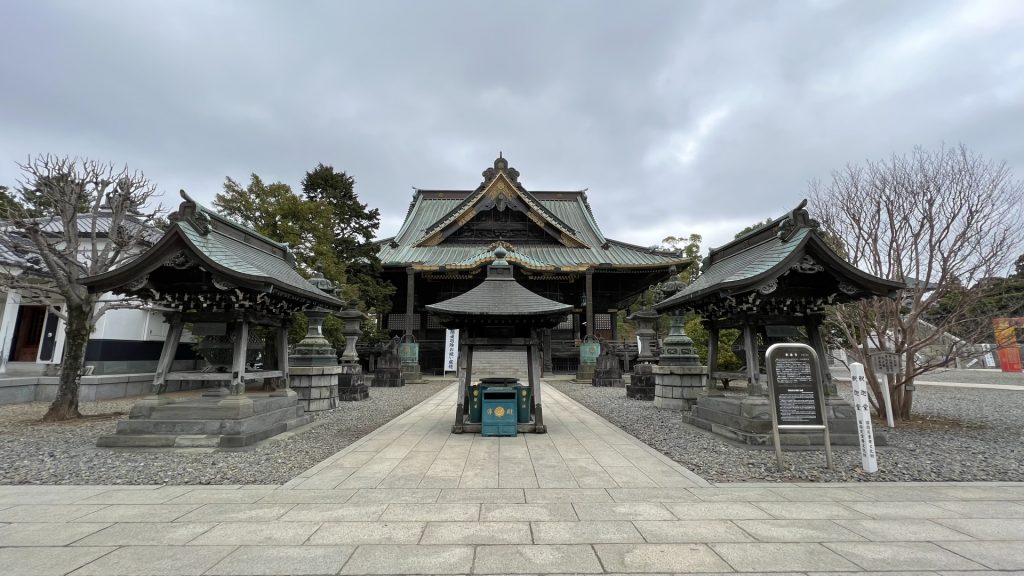
About the sect of Buddhism to which Naritasan Shakado belongs (Chisan sect of Shingon sect) and its teachings
Naritasan Shakado is a Buddhist temple belonging to the Shingon sect of Buddhism. Below is an overview of the Chisan School of Shingon Buddhism and its teachings.
Chizan School of Shingon Buddhism: Chizan school of Shingon Buddhism is a sect of Shingon Buddhism founded by Kukai (Kobo Daishi, Koukai) in the early Heian period. Kukai is one of the central figures in Japanese Buddhism and is known for spreading the esoteric teachings he brought with him to Japan.
The Shingon sect is a sect of esoteric Buddhism that aims to purify the mind and body and attain enlightenment by practicing darani and shingon spells that use special syllables called shingon. Mantra is a word unique to esoteric Buddhism, and it is believed that it has a special meaning, and when chanted, it exerts a mysterious power.
As the name suggests, the Chisan sect of Shingon Buddhism has Chionzan as its head temple. Naritasan Shakado is positioned as a branch temple of the Chisan sect, and exists as one of the temples that inherits the light of Mt. Chion.
Teachings and practices: The Chizan sect of Shingon Buddhism practices ascetic practices based on esoteric Buddhism teachings. Trainees aim to purify their minds and attain enlightenment by receiving special teachings from their masters and reciting mantras and darani mantras. In addition, training using Buddha statues and mandalas is also performed.
The teachings of the Chizan School are particularly sophisticated and profound among esoteric Buddhism, and master-student relationships and traditions play an important role in training. The teachings of esoteric Buddhism are rarely open to the public and many of them are secret, so many of them are not well known to the general public.
Naritasan Shakado is believed to have inherited the teachings of the Chizan School of Shingon Buddhism, and to conduct esoteric Buddhism training and ceremonies. Temple buildings, Buddha statues, and rituals are protected according to the traditions and teachings of the Chisan school.
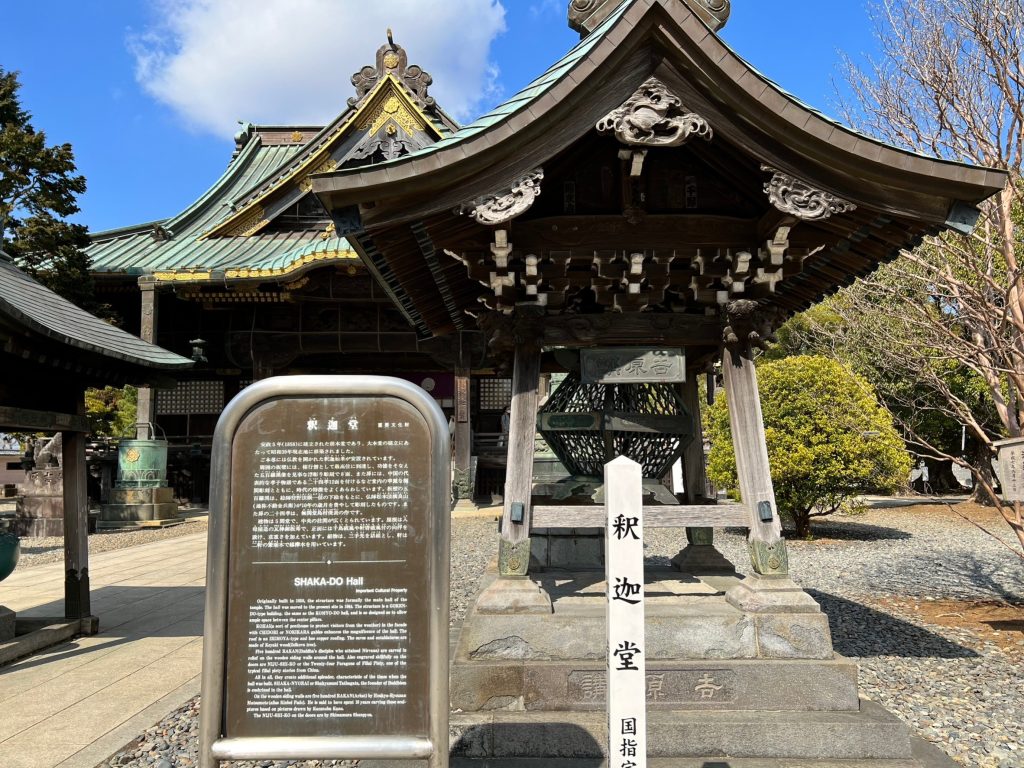
Appearance, internal structure, characteristic design and decoration of Naritasan Shakado building
Naritasan Shakado is a beautiful temple with traditional Japanese architecture. Below is a general explanation of the exterior and interior structure of the Naritasan Shakado building, as well as its distinctive design and decoration.
Appearance: The appearance of Naritasan Shakado reflects the characteristics of ancient Japanese temples. In general, there is a sense of solidity, and wooden structures are characteristic. The roof is tiled with a curved slope, and the tip of the roof is decorated with onigawara (ogre tiles) and lion tiles (shishigawara).
Temples often have distinctive gates and pagodas in front to welcome worshipers. In many cases, Sanskrit characters (Bonji) and Buddhist sculptures are applied to the gate of Naritasan Shakado.
Internal structure: The interior of Naritasan Shakado is designed as a space for worshipers to worship quietly. Generally, there is a central altar and Buddha statue called the main hall (Shakado). A statue of Shakyamuni Buddha (Shakyamuni Buddha) is usually enshrined in the center.
The interior of the main hall is supported by wooden pillars and beams, and the texture and carvings of the wood are designed to look beautiful. The ceiling may also have paintings and decorations. Inside, there is a tatami-matted floor, and a space divided by cushions and fusuma (sliding doors), where worshipers sit in meditation and make offerings.
Distinctive design and decoration: Naritasan Shakado is characterized by design and decoration that reflect traditional Japanese aesthetics. Buddhist statues, paintings, and mandalas that are carved and painted are displayed inside and outside the temple.
In particular, the mandala is a symbol of esoteric Buddhism and has a colorful pattern. These decorations and paintings are visual representations of Buddhist teachings and doctrines and serve to convey the teachings to the worshipers.
Another characteristic of Naritasan Shakado is the natural beauty of the garden and precincts of the temple, which changes with the seasons. The beautiful scenery that changes with the seasons provides a place for worshipers to spend a quiet time.
As described above, Naritasan Shakado is a beautiful temple that fuses traditional Japanese architecture and aesthetics, and is loved by many worshipers and tourists.
About the statue of Shakyamuni Buddha enshrined in Shakado
The image of Shakyamuni Buddha (Shakyamuni Buddha) enshrined in the Shakado Hall of Naritasan Shakado is a very important Buddha statue and is loved and loved by many worshipers and believers. The following is a description of the statue of Shakyamuni Buddha that is generally enshrined in Shakado.
- Shakyamuni Buddha Statue: Shakyamuni Buddha is generally in a sitting position. This represents the appearance of Shakyamuni Buddha when he attained his enlightenment. The posture is often placed on a special pedestal, such as the lotus position or the lion position.
- Hand poses (mudras): Buddha statues may exhibit various hand poses (mudras). Typical examples include “kekkafuzazain” and “hokoin”. These hand poses have special meanings and are symbolic of Buddhist teachings.
- Expression: Shakyamuni Buddha statues generally have a calm and loving expression. This expresses the teaching that Shakyamuni Buddha is a being full of wisdom and compassion.
- Body Decorations: Shakyamuni Buddha statues may have body decorations such as robes and crowns. The robes are worn by Buddhist monks and symbolize the appearance of Shakyamuni Buddha when he preached the teachings of Buddhism.
- Materials and Coloring: Shakyamuni Buddha statues may be made of a variety of materials, including wood carving, stone carving, and metal. In addition, the Shakyamuni Buddha statue is sometimes painted with beautiful colors, and you can also see the Buddha statue painted in vivid colors.
With these elements, the Shakyamuni Buddha statue enshrined in Naritasan Shakado expresses the teachings, wisdom, and mercy of Shakyamuni Buddha, and gives a deep impression to the hearts of worshipers. The Shakyamuni Buddha statue is an important symbol of Buddhism and is revered as the central object of Naritasan Shakado.
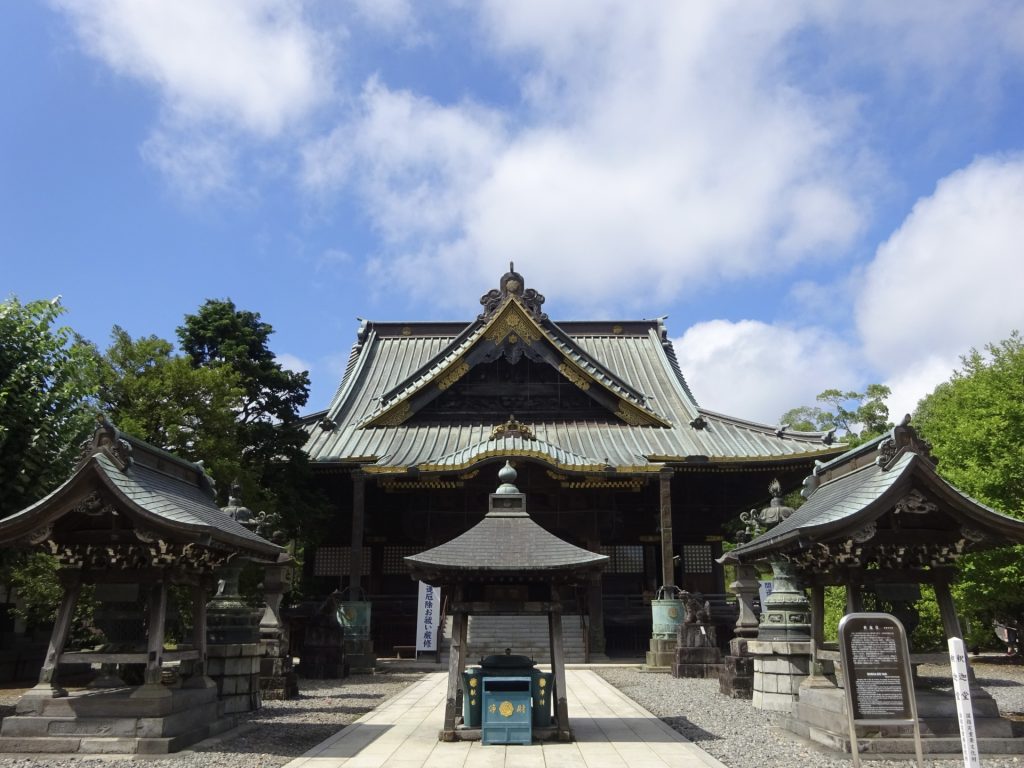
Manners and procedures for visiting Naritasan Shakado
The manners and procedures for worshiping when visiting Naritasan Shakado are general rules common to worshiping at traditional Japanese temples. Below are some examples of common worship etiquette and procedures:
- Greeting at the entrance: When you arrive at the entrance of the temple, put your hands together and bow lightly. Greetings are important in Japan, and politeness is important even when visiting temples.
- Foot Wipes: Before entering the temple grounds, there may be a place to wipe the soles of your feet, such as at the entrance. Avoid entering the precincts with your shoes on, and wipe them off before entering.
- Offerings: There is usually a saisen box at the entrance of a temple. Put your hands together or bow your head before putting the money into the box. The amount is not fixed, but generally it is about 10 to 100 yen.
- Entering sanctuaries: When entering sanctuaries such as the Shakado and the main hall, it is common to remove your shoes. When you take off your shoes, you can arrange them in a designated area or put them in a bag and carry them with you.
- Procedure at the main hall: When entering the main hall, it is common to enter with the left foot first when passing through the gate. Once inside, stand quietly with your feet together and put your hands together to prepare your mind. Also, refrain from taking pictures and talking.
- Pilgrimage: Pray with your hands together facing the statue of Shakyamuni Buddha. It’s a good idea to convey your wishes and feelings of gratitude in your heart. The hand pose (mudra) is also sometimes done during worship.
- Incense sticks: If you want to burn incense sticks, light the provided sticks and put your hands together before burning the sticks. It is customary to place fires in designated areas.
- Regarding photography of the sanctuary: Although it may be possible to take pictures, please be careful not to point the camera directly at the sanctuary or the Buddha statues. Avoid using flash and be careful not to disturb other worshipers.
- Proper etiquette when leaving: When leaving, put your hands together and bow lightly before leaving.
By following these worship etiquette and procedures, you can visit Naritasan Shakado in a comfortable and respectful manner. Also, since each temple may have different manners and procedures, it is recommended to check the temple’s official website and information before visiting.
Highlights of the precincts of Naritasan Shakado
The precincts of Naritasan Shakado is a spot where beautiful nature and historical buildings merge, and there are plenty of places to see. Here are some of the main highlights of the precincts of Naritasan Shakado:
- Main Hall (Shakado): The main hall (Shakado), which is the center of Naritasan Shakado, enshrines a statue of Shakyamuni Buddha (Shakyamuni Buddha). With its beautiful Buddha statues and unique atmosphere, it attracts many worshipers.
- Three-storied pagoda (five-storied pagoda): There are three-storied pagodas and five-storied pagodas in the precincts, and you can enjoy the beauty of traditional Japanese pagodas. The pagoda sits at the center of the building and offers a glimpse into ancient Japanese architecture.
- Senbon Torii: Naritasan Shakado has beautiful Senbon Torii. You can walk along the approach lined with torii gates and enjoy a special atmosphere.
- Niomon Gate: The Niomon Gate is located at the entrance of the temple and is guarded by a large Nio statue. Its powerful appearance is impressive, and you can pass through it before worshiping.
- Garden: There is a beautiful garden in the precincts of Naritasan Shakado. You can enjoy the beauty of nature by strolling through the garden, which changes its appearance with the seasons.
- Five-storied pagodas and turrets: There are many five-storied pagodas and turrets in the precincts. These towers are one of the tourist attractions and attract visitors as a building of high historical value.
- Souvenir shops along the approach: Souvenir shops and restaurants line the approach. After visiting the temple, you can shop for souvenirs and taste local delicacies.
These are the main highlights of the precincts of Naritasan Shakado, but if you actually visit, you will find many more beautiful places and attractive spots. We recommend taking a leisurely stroll through the grounds while feeling the breath of history and nature.
Events, annual events, and special events held at Naritasan Shakado
At Naritasan Shakado, various events are held throughout the year. Below is a list of some of the most popular and special events.
- Oshogatsu (New Year’s Day Festival): At Naritasan Shakado, New Year’s visits to shrines are held on New Year’s Day (January 1st). Many worshipers come to pray for happiness in the new year and to express their gratitude to Shakyamuni Buddha.
- Setsubun: Setsubun events are held at Naritasan Shakado on February 3rd. Ceremonies to ward off bad luck and ward off evil spirits, such as throwing beans and distributing lucky beans, are held.
- Flower Festival: A flower festival is held in spring, and the precincts of Naritasan Shakado are decorated with beautiful flowers. Especially during the cherry blossom season, festivals are held to celebrate the blooming of cherry blossoms.
- Obon (Urabon-e): During Obon (July 15th), the Urabon-e is held to honor ancestors. Many people come to remember their deceased family members and ancestors, visit graves and make offerings.
- Festivals: Festivals are held regularly at Naritasan Shakado. Local traditional festivals such as summer festivals and autumn festivals are sometimes held.
- Kodo Memorial Service: Kodo memorial service is held regularly, and Buddhist monks give sermons and sutra chanting. It is an opportunity for worshipers to participate in Buddhist memorial services, learn the teachings of Buddhism, and purify their minds.
The events and events mentioned above show that Naritasan Shakado is a central presence in the area as a Buddhist temple. However, the dates and content of events may change from year to year, so it is important to check the latest information on the official website or contact the office before visiting.
